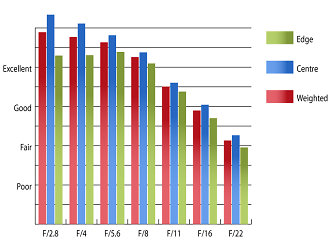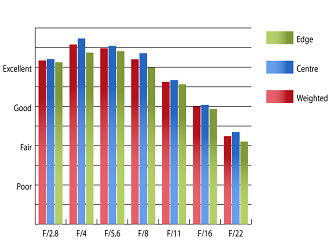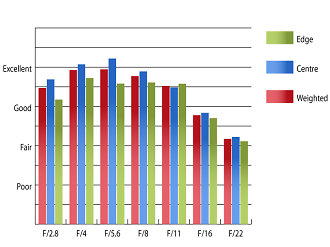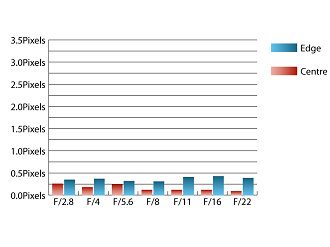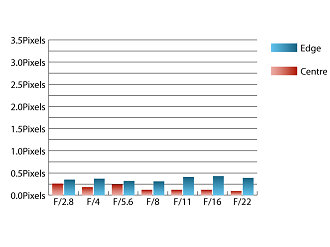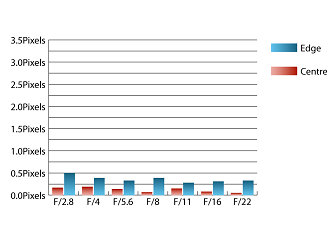Olympus M.Zuiko Digital ED 7-14mm f/2.8 PRO Review
Olympus 7-14mm f/2.8 PRO Performance
At 12mm sharpness is already outstanding in the centre of the frame and excellent towards the edges. The performance of the lens at this focal length is limited by diffraction, so there is nothing to be gained in sharpness by stopping down.
Zooming to 10mm results in a slight reduction in sharpness at maximum aperture, although performance is still excellent across the frame at maximum aperture. Stopping down to f/4 results in outstanding sharpness in the centre of the frame and excellent clarity towards the edges.
Finally, at 14mm sharpness is very good in the centre and good towards the edges of the frame at maximum aperture. Stopping down to between f/4 and f/5.6 results in excellent clarity in the centre and very good performance towards the edges for this focal length.
How to read our charts
The blue column represents readings from the centre of the picture frame at the various apertures and the green is from the edges. Averaging them out gives the red weighted column.The scale on the left side is an indication of actual image resolution. The taller the column, the better the lens performance. Simple.
For this review, the lens was tested on a Panasonic Lumix G6 using Imatest.
Chromatic aberrations are extremely well controlled throughout most of the zoom range for this kind of lens. Fringing barely exceeds half a pixel width, which should make these chromatic aberrations difficult to spot.
How to read our charts
Chromatic aberration is the lens' inability to focus on the sensor or film all colours of visible light at the same point. Severe chromatic aberration gives a noticeable fringing or a halo effect around sharp edges within the picture. It can be cured in software.Apochromatic lenses have special lens elements (aspheric, extra-low dispersion etc) to minimise the problem, hence they usually cost more.
For this review, the lens was tested on a Panasonic Lumix G6 using Imatest.
Chromatic aberrations are extremely well controlled throughout most of the zoom range for this kind of lens. Fringing barely exceeds half a pixel width, which should make these chromatic aberrations difficult to spot.
Falloff of illumination towards the corners is also well controlled. At 7mm and f/2.8 the comers are 1.52 stops darker than the centre of the image and at 14mm the corners are only 1.27 stops darker than the image centre. Stopping down to f/5.6 results in visually uniform illumination across the frame throughout the zoom range.
Distortion is well corrected in camera, but without corrections applied, Imatest detected 1.73% barrel distortion at 7mm which reduces to 0.61% at 14mm. The distortion pattern is uniform across the frame throughout the zoom range, which should make applying corrections in image editing software afterwards fairly straightforward.
A petal-shaped hood is built onto the front of the lens, which does a reasonable job of shading the lens from extraneous light that may cause issues with loss of contrast or flare. Strong sources of light in the frame, such as the sun can cause flare and a noticeable loss of contrast.
Value For Money
Currently, this lens is available for around £1000, which is good value for a lens of this quality. There is no direct equivalent currently available for Micro Four Thirds cameras, with the closest alternative being Panasonic’s 7-14mm f/4 lens, which costs around £800.
But I like DSLR
Add your message
Please login here or if you've not registered, you can register here. Registering is safe, quick and free.
photodo Stats
428 MTF tests
74 in-depth photodo reviews
100+ users join each day
Help the lens community by reviewing or rating a lens today via our lens search
Latest Lens Reviews
- Chinon 28mm f/2.8 Vintage Lens Review
- Canon EF 70-200mm f/4L IS II USM Lens Review
- Samyang AF 85mm f/1.4 EF Review
- Sigma 70mm f/2.8 DG Macro Art Review
- Samyang AF 24mm f/2.8 FE Review
- Meike 50mm f/1.7 Review
- Tamron 70-210mm f/4 Di VC USD Review
- Lensbaby Burnside 35mm f/2.8 Review
- Asahi Super Takumar 50mm f/1.4 Review
- Asahi Super-Multi-Coated Takumar 135mm f/3.5 Review
